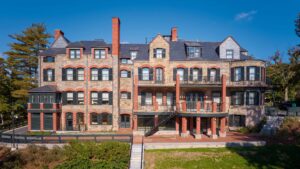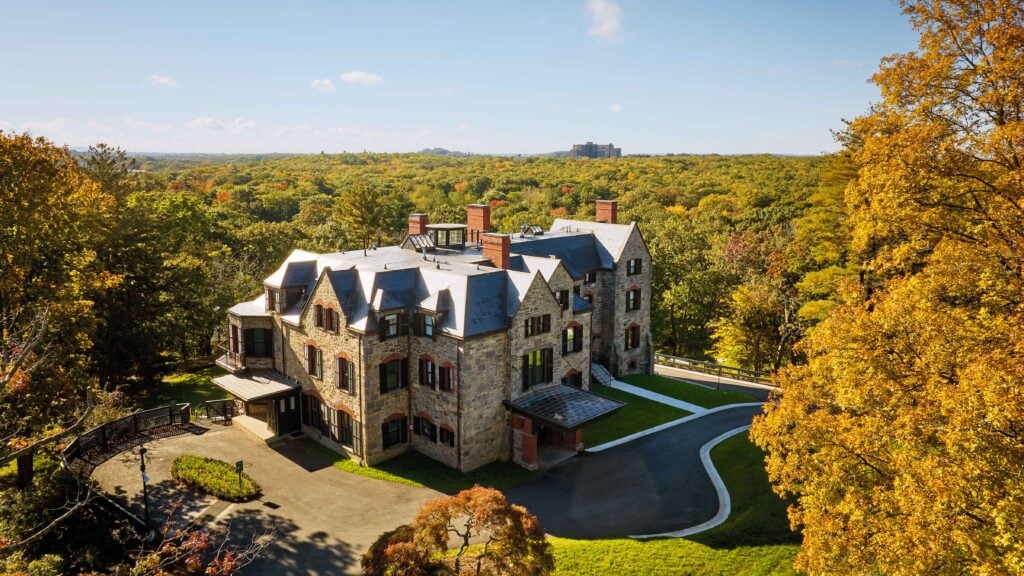The largest and most complex project Longyear Museum has ever undertaken—restoring Mary Baker Eddy’s final residence at 400 Beacon Street in Chestnut Hill, Massachusetts—stretched across much of a decade, employed a cast of nearly a thousand, and required every ounce of commitment, dedication, and inspiration that Longyear’s talented staff could muster.
“The project represents almost eight years of prayerful attention and quiet listening for guidance on every aspect of the restoration,” says Rex Nelles, Longyear’s senior manager of historic houses. “Each step of progress came with its challenges, but also with the rewards of overcoming each issue.”
Across those many years, through thousands of restoration decisions, one goal was always foremost in thought for the team. “The aim for any restoration of Mary Baker Eddy’s houses,” Rex continues, “is to give a correct impression of what life would have been like in the house and what it would have looked like. Mrs. Eddy would not have accepted water damaged wallpaper and crumbling plaster. Her homes were meticulously kept.”
In a marked departure from traditional historic preservation practices (which seek to maintain original structures and artifacts “as is,” no matter their current condition), Longyear undertook the restoration with a unique focus: to share the story of the Discoverer, Founder, and Leader of Christian Science in the most vivid and meaningful way, to have the house feel as it did when Mrs. Eddy and her staff lived there. At the heart of the work was an unwavering commitment to detail and quality, with an eye to ensuring the home’s soundness for at least another century.
The vision for the restoration has now been realized, but the road that led here was a long one.
* * *
Longyear Museum purchased 400 Beacon Street in December 2006. The first few years afterward were a get-to-know-you period, as staff became familiar with the upkeep and maintenance demands of two large buildings—the 18,000-squarefoot house and the combined 7,300-square-foot carriage house and gatehouse—as well as the 8.5-acre site.
Even with minimal furnishings and timeworn interior and exterior areas, the house remained open for tours. “Somehow, we had to convey stories without many ‘props’ to support them,” Longyear Executive Director Sandy Houston explains. “This pushed us to get to the real essence of why this house is important: It’s because of all that was accomplished, all that happened here … in terms of Mrs. Eddy fulfilling her mission.”
As staff and trustees cherished the potential of 400 Beacon Street to foster public understanding and appreciation of Mrs. Eddy’s life and work, private gifts and a $500,000 grant from the Massachusetts Cultural Facilities Fund opened the way to move into an initial phase of restoration in 2015. Phase I, which lasted almost two years, focused on replacing and making safe key structural and mechanical elements, including repointing crumbling mortar and restoring windows on nearly half of the building; replacing part of the roof; installing a new water main and sewer line; abatement of hazardous materials; and addressing basic accessibility issues. Inside the house, two areas were selected for renovation and interpretation: the kitchen and a staff member’s room. This phase addressed some of the most urgent needs, and it also helped prepare the team for more extensive work—while giving visitors a glimpse of what a fully restored home would look like.
“Mrs. Eddy’s story was always at the center of our decisions,” Sandy notes. “We would ask ourselves, ‘How does this renovation decision or inclusion of that artifact convey something meaningful about Mrs. Eddy’s life and work? What will the visitor learn and experience of the accomplishments that took place here?’”
In 2018, thanks to the support of generous donors, Longyear was able to embark on planning for the second phase of the restoration. Construction began in the spring of 2020. During Phase II, more than 600 men and women worked on-site and an estimated 300 were engaged in off-site locations. Work continued uninterrupted through the pandemic shutdowns of 2020 and 2021. Architects, consultants, contractors, subcontractors, and Longyear staff had to be flexible, cooperative, creative, and in constant communication to ensure progress.

Some of the work during this phase included major infrastructure updates such as all-new electrical service, a backup generator, air-conditioning, more energy-efficient heating and ventilation, a sophisticated fire-detection and -suppression system, and improved security. The renovation included rebuilding the kitchen porch (at far left in photo above) and demolishing and rebuilding the two-story south porch (above, right); expanding visitor parking; restoring the wrought iron gates; building retaining walls and stairways; shoring up the massive stone wall of the carriage house (a major engineering feat); and carving out a bright, spacious, all-new visitor center in what was once the cramped, dim basement.
CLICK HERE to learn about the long-term solutions Longyear implemented to restore the exterior and make the house weathertight.
CLICK HERE to explore some of the landscaping and infrastructure features that will help maintain the property well into the future.
Refurbishing and interpreting 28 period rooms was another massive undertaking. The process included repairing or replacing crumbling plaster and remediating calcimine washed ceilings, where paint would not adhere; replacing water-damaged wallpaper and worn carpeting; restoring woodwork, doors, and windows; converting gas light fixtures to electric and rewiring old electric fixtures; painting walls, ceilings, and trim; reupholstering original furniture (donated by The Mother Church, The First Church of Christ, Scientist, in 2016); and acquiring historically accurate artifacts where no originals existed. (For more on the interior restoration, see “The Dearest Spot on Earth” online series and keep an eye out for “Evoking a Sense of Time and Place,” which will be published online in April.)
The 2024 reopening of 400 Beacon Street provides a unique opportunity to share the expansive story of Mrs. Eddy’s lasting achievements, supported by her staunch workers and trusted aides—whom she called her “family.”
Longyear’s comprehensive restoration “embraces the whole house and household,” Sandy concludes. “What we can learn about Mrs. Eddy through the experiences of the household staff is so valuable. This house enables us to tell Mrs. Eddy’s story, as well as share what it was like to live and work under her direction.”
